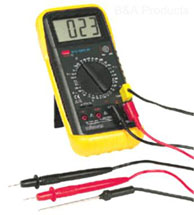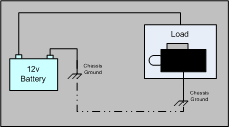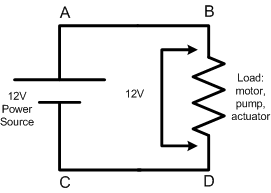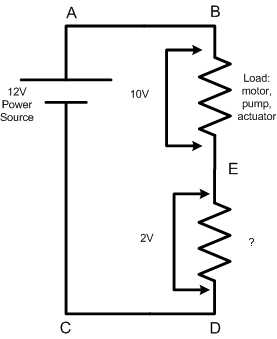How a Volt Meter Works
A volt meter determines the potential difference between two voltage points in a circuit. The following table will illustrate what a volt meter will register given the following conditions:

A web site named All About Circuits did a pretty good job at explaining how voltage sensing works and how voltage sensing could affect a circuit. <...Learn More...>
| Red Lead | Black Lead | DVM Read Out |
|---|---|---|
| 12V | 0V | 12V |
| 0V | 12V | -12V |
| 12V | 5V | 7V |
Kirchoff's Voltage Law (KLV)
In a nutshell, we are going to leverage Kirchoff's Voltage Law in that all voltage is consumed by the expected load in a circuit. Thinking of it this way will allow you to understand how a voltage drop test leverages this law.
The expected load of the following circuit is the starter.

In my humble opinion, Jim Pytel's YouTube video did an awesome job explaining Kirchhoff's Voltage Law, KLV.
 <...Learn More...>
<...Learn More...>
Simple Circuit with No Corrosion
Single Load
Before using the JAVA Circuit Simulator, let's discuss what we expect the voltage values to be around a circuit. Let us look at a simple series circuit:
This healthy circuit allows the load to receive the complete 12V from the power source.
| Red Lead | Black Lead | DVM Read Out |
|---|---|---|
| A | B | 0V |
| A | C | 12V |
| C | D | 0V |
| B | D | 12V |
How Corrosion Affects Circuits
Two Loads
Now, let's compare what happens to the primary load when additional resistance is added. The following diagram depicts a possible set up:
The mystery resistance steals some voltage from the primary load. This mystery load is corrosion, damaged wire, damaged connector, and/or corroded connector.
Due to Kirchoff's Voltage Law, we know that all the voltage will be consumed by all the loads in a circuit. So, we know that both loads will share the voltage. But, due to this, the primary load is not receiving all the voltage it needs to perform its job efficiently. Remember, corrosion adds resistance to a circuit. So as the corrosion in a circuit builds up more and more, the resistance increases and the voltage it robs becomes more parasitic. After a while, the primary load will not receive enough voltage.
Voltage Drop Test
Now that we have described how corrosion can add hidden resistance to a circuit, we leverage the voltage drop test to find it. Now, let's leverage the JAVA Circuit Simulator to visualize Voltage Drop and how the Voltage Drop Test functions.